Soft Amish White Bread
For a soft, basic white sandwich bread, you can’t do much better than this. A friend of mine whose parents owned a bakery gave me this recipe and said they bake 20 loaves every morning. You might not have such grand ambitions but I think you’ll love it just as much.
Remember that you might need to add a tiny bit more liquid or give it a little more time to rise, especially in winter. As you get more comfortable with yeast breads over time, these tweaks will become second nature.
Amish White Bread
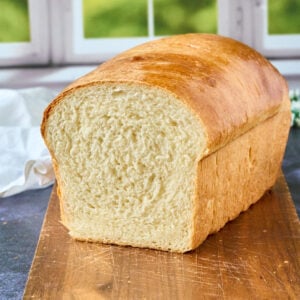
Equipment
- 8 1/2 x 4 1/2 x2 1/2 loaf pan
- Large mixing bowl (for first rise)
- Plastic Wrap
- Bread machine or stand mixer ((helpful but not necessary)
Ingredients
For the Bread
- 3 cups all-purpose flour
- 1 cup milk (may need up to 2 additional tablespoons)
- 2 tablespoons butter (melted)
- 2 tablespoons sugar
- 1 ½ teaspoons salt
- 2½ teaspoons instant yeast (SAF brand is recommended)
For Brushing the top
- 1 egg
- 1 teaspoon water
Save This Recipe
You'll join my email list which you will love. And if you don't, unsubscribe in one click. ❤️
Instructions
- Mix the ingredients. Add all the bread ingredients (flour, milk, melted butter, sugar, salt, and yeast) to an electric stand mixer or a large mixing bowl. Mix on low speed (or by hand with a wooden spoon) until a dough forms that holds together and does not stick to the sides or bottom of the bowl. If the dough seems too dry and crumbly, add more water, one teaspoon at a time. If it's too sticky, add more flour, one tablespoon at a time, until the desired consistency is reached.
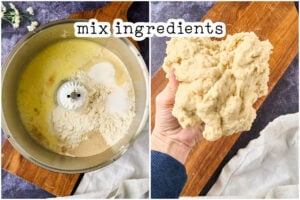
- Knead. Knead the dough by machine or by hand for 10-15 minutes until it is smooth and soft and reaches the windowpane stage (a translucent area appears when the dough is stretched). If you're using a stand mixer, allow the machine to rest for a few minutes every five minutes of kneading to prevent overheating.

- The first rise. Shape the dough gently into a ball and place it into a clean, lightly oiled bowl. Cover with a clean, damp tea towel and place in a warm, draft-free area. Let the dough rise for about 60 minutes or until it is puffy and has doubled in size.

- Shape. After the first rise, gently stretch the dough into a rectangle. The short side of the rectangle should be the same length as the long side of your loaf pan. Tuck in the corners and top of the dough, then roll it into a log. Pinch the seams closed and place the loaf, seam side down, into a lightly oiled loaf pan.

- The second rise. Cover the loaf with heavily greased plastic wrap and place it back in a warm area to rise again. Let it rise until the dough is about one inch above the top of the loaf pan. Once it has risen, preheat your oven to 350°F (175°C). Before baking, generously brush the top of the loaf with the beaten egg mixed with water.

- Bake. Bake the bread at 350°F (175°C) for 45-50 minutes, or until the loaf reaches an internal temperature of 200-210°F (93-99°C) and sounds hollow when tapped. Remove the bread from the loaf pan and allow it to cool completely on a wire rack before slicing. The bread will stay fresh for 2 days at room temperature or can be frozen for up to 2 months.

Notes
Nutrition
Did You Make This?
I would love it if you would leave a review!More Tips:
Dough can be tricky depending on the weather. If it’s a humid day, your dough might need a bit more flour to avoid sticking. On drier days, you might need a little extra milk or water to get the right consistency.
A Newsletter you’ll love
Daily recipes from the farmhouse, Sunday meal plans, seasonal ideas, straight from my kitchen to your inbox.
I promise to keep your email address safe. Unsubscribe at any time
If your kitchen is cool, the dough might take longer to rise. A trick is to preheat your oven to the lowest setting for a few minutes, turn it off, and then place the covered dough inside the oven to rise. Just make sure the oven isn’t too hot—it should feel warm, not hot, to the touch.
It’s more important to watch your dough than watching the clock. Look at the step-by-step pictures to see when the rising is done. Even if an hour has passed, if it hasn’t risen enough, give it more time.
Make sure you have kneaded long enough. It’s very rare to over-knead but quite common to under-knead. When in doubt, keep going.
Don’t forget to grease the bowl and plastic wrap. This will make it easier to remove the dough from the bowl, shape it, and remove the wrap after the final proof.
Once you’ve shaped the dough into a loaf, handle it gently. Overworking it at this stage can deflate the air bubbles you worked so hard to create during the rise, leading to a denser loaf.
If you don’t have a thermometer to check if your bread is done, tap the bottom of the loaf—it should sound hollow. If it doesn’t, pop it back in the oven for a few more minutes.

Key Ingredients and Tools
Instant yeast: This yeast is quicker and more dependable than active dry yeast, but you can definitely use active dry as well. There’s no need to proof it beforehand, just follow the recipe as written.

Stand mixer: While kneading the dough by hand is possible, a stand mixer makes your life easier and you’ll end with a fluffier loaf.
Loaf pan: A standard 8 1/2 x 4 1/2-inch loaf pan gives the bread its classic shape and ensures even baking.
I hope this bread becomes a tradition in your house, and that most importantly, it shows you how easy it is to make your own.

Love,


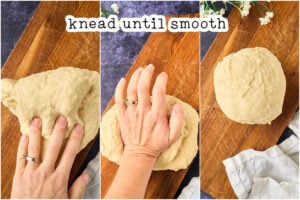
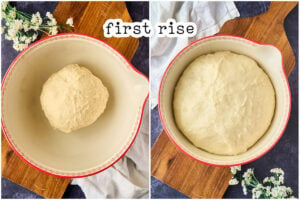
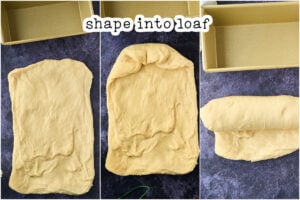
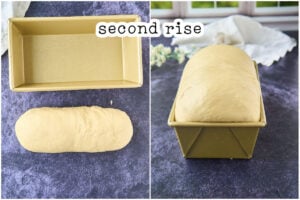
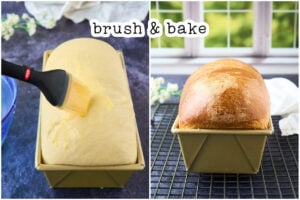









I’m too impatient to wait for the dough to rise, so I warm the milk and melt the butter at the same time. Works like a charm.
I also skip the egg wash and just coat it with butter when it is fresh from the oven.
hey Julie! yes that definitely works! glad you’re enjoying the recipe 🙂
Love this recipe!!!
I’m just starting out with homemade bread making so, bless their hearts, but my kids are my bread taste testers …. as of today they all agree this recipe is by far their favorite!! Mine too. Easy to make!
Thank you for sharing!!! 🥰
Hey Amanda, thank you so much! I’m so happy to hear that your kids love the recipe what great taste testers! Homemade bread-making is such a fun journey. I hope you keep enjoying it! Happy baking!
I followed the directions as written and didn’t realize I needed to warm the milk and so my dough didn’t rise. What a waste.
hello amariah. you DON’T need to warm the milk! it will raise if given enough time
My dough didn’t rise like in the picture 😒 I followed it step by step🤷♀️ What did I do wrong? Any idea 💡
it just depends. more likely culprits: your dough was a little too dense and needed a splash more liquid (happens all the time in the winter because the air and the flour are so dry), or your kitchen is cold and it just needed a little more time.
when I pulled the foil off the rising do it just collapsed even before I could put the egg/water mixture on it.
how can I put the mixture on it without the do collapsing?
it could have over=risen or the cover could have stuck to the dough. i always use glastic wrap and spray it with cooking spray very heavily. you can also brush it before the second rise.
This is a nice loaf of bread, but contains a little too much sodium per slice in my opinion. The fault with commercial sandwich loaves is the same thing: too much salt and sugar. I make mine with less of each for a healthier option. One slice should not contain over 100 mgs of salt at best.
really good and tasty thanks for the good recipe
this bread is wonderful
it’s my only go to now
Hi! My dough isn’t rising, I bought new yeast and tried again a second time and still not rising. Is the milk supposed to be warm?
hey caitlin, no the milk doesn’t need to be warm! is your dough in a warm place? not hot, but warm? it WILL rise!!! 🙂 keep me posted, you can email me!
This is the best bread I have ever baked . I even add about a cup of my sour dough starter to it and it’s the best texture and taste . Thank you for posting this wonderful Bread !!
thank you debbie! it is so soft isn’t it. so glad you love it 🙂
I made this two times so far. And my family enjoys this bread. Simple ingredients that I have on hand. I adjusted using warm milk the first time and the second time I used cold milk but I had to adjust the rising time. I liked the way it came out both times.
Just a question. What happens if your dough doesn’t rise? Mine Disney rise very much at all
couple of possibilities: your dough might have been too dry or it might have been in too cool a place. if you leave it long enough, it will rise eventually, even in a cooler kitchen, but putting it into a slightly warmed up over will speed up the process.
I haven’t made this yet but it is very similar to my favorite sourdough recipe. I just wanted to leave a tip: Wet is better than dry. If you are making the dough and wondering if the dough is too dry add just a BIT of water. A wetter dough rises better than a dry dough.
such a good tip! once people get the feel of what their dough “should” look/ feel like, bread baking is a breeze 🙂